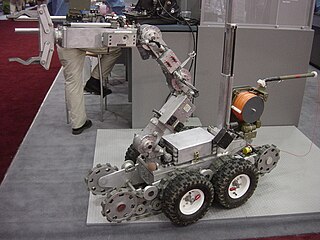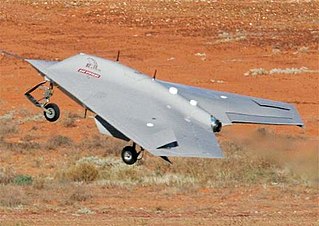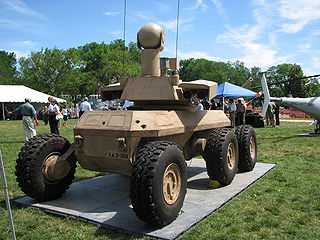 W
WMilitary robots are autonomous robots or remote-controlled mobile robots designed for military applications, from transport to search & rescue and attack.
 W
WThe 30mm DS30M Mark 2 is a ship-protection system made by MSI-Defence Systems consisting of a 30mm Mark 44 Bushmaster II cannon on an automated mount. It was designed to defend Royal Navy frigates from fast inshore attack craft armed with short-range missiles, rocket-propelled grenades, machine guns or explosives.
 W
WThe ANDROS is a series of remote control military robots designed by REMOTEC, a subsidiary of Northrop Grumman. The ANDROS series is primarily designed for military, explosive ordnance disposal (EOD), and law enforcement or SWAT applications. The ANDROS gained notability in 2016 for being involved in the first instance of a robot being used to kill another person, Micah Xavier Johnson, the gunman involved in the 2016 shooting of Dallas police officers.
 W
WBerserk is an unmanned remotely controlled combat complex that was developed in the Republic of Belarus in 2018. The combat complex is equipped with two four-barrel rapid-firing aircraft machine guns GShG-7.62 and designed for engagement of small-size UAVs and enemy troops. For the first time, Berserk was presented at the parade of troops of the Minsk garrison on July 3, 2019 in honor of Independence Day of the Republic of Belarus.
 W
WBigDog is a dynamically stable quadruped military robot that was created in 2005 by Boston Dynamics with Foster-Miller, the NASA Jet Propulsion Laboratory, and the Harvard University Concord Field Station. It was funded by DARPA, but the project was shelved after the BigDog was deemed too loud for combat.
 W
WThe Borgward IV, officially designated Schwerer Ladungsträger Borgward B IV, was a German remote-controlled demolition vehicle used in World War II.
 W
WThe Campaign to Stop Killer Robots is a coalition of non-governmental organizations who seek to pre-emptively ban lethal autonomous weapons.
 W
WCounter rocket, artillery, and mortar, abbreviated C-RAM or counter-RAM, is a set of systems used to detect and/or destroy incoming rockets, artillery, and mortar rounds in the air before they hit their ground targets, or simply provide early warning.
 W
WThe Goliath tracked mine was a series of two unmanned ground vehicles used by the German Army as disposable demolition vehicles during World War II. These were the electrically powered Sd.Kfz. 302 and the petrol-engine powered Sd.Kfz. 303a and 303b. They were known as beetle tanks by the Allies.
 W
WThe Legged Squad Support System (LS3) was a DARPA project for a legged robot which could function autonomously as a packhorse for a squad of soldiers or marines. Like BigDog, its quadruped predecessor, the LS3 was ruggedized for military use, with the ability to operate in hot, cold, wet, and dirty environments. The LS3 was put into storage in late 2015.
 W
WLethal autonomous weapons (LAWs) are a type of autonomous military system that can independently search for and engage targets based on programmed constraints and descriptions. LAWs are also known as lethal autonomous weapon systems (LAWS), autonomous weapon systems (AWS), robotic weapons, killer robots or slaughterbots. LAWs may operate in the air, on land, on water, under water, or in space. The autonomy of current systems as of 2018 was restricted in the sense that a human gives the final command to attack - though there are exceptions with certain "defensive" systems.
 W
WThe Multi-function Agile Remote-Controlled Robot (MARCbot) is a military robot created by Exponent Inc. for the United States Army Rapid Equipping Force.
 W
WPackBot is a series of military robots by Endeavor Robotics, an international robotics company founded in 2016, created from iRobot, that previously produced military robots since 1990. More than 2000 were used in Iraq and Afghanistan. They were also used to aid searching through the debris of the World Trade Center after 9/11 in 2001. Another instance of the PackBot technology being implemented was to the damaged Fukushima nuclear plant after the 2011 Tōhoku earthquake and tsunami where they were the first to assess the site. As of November 2014, the U.S. Army is refurbishing 224 iRobot 510 robots. The PackBot technology is also used in collaboration with NASA for their rovers and probes.
 W
WThe Phalanx CIWS is a close-in weapon system for defense against incoming threats such as small boats, surface torpedoes, anti-ship missiles and helicopters. It was designed and manufactured by the General Dynamics Corporation, Pomona Division, later a part of Raytheon. Consisting of a radar-guided 20 mm (0.8 in) Vulcan cannon mounted on a swiveling base, the Phalanx has been used by the United States Navy and the naval forces of 15 other countries. The US Navy deploys it on every class of surface combat ship, except the Zumwalt-class destroyer and San Antonio-class amphibious transport dock. Other users include the British Royal Navy, the Royal Australian Navy, the Royal Canadian Navy and the US Coast Guard.
 W
WThe SGR-A1 is a type of sentry gun that was jointly developed by Samsung Techwin and Korea University to assist South Korean troops in the Korean Demilitarized Zone. It is widely considered as the first unit of its kind to have an integrated system that includes surveillance, tracking, firing, and voice recognition. While units of the SGR-A1 have been reportedly deployed, their number is unknown due to the project being "highly classified".
 W
WThe Mittlerer Ladungsträger Springer was a demolition vehicle of the German Wehrmacht in World War II.
 W
WSYRANO is the first operational battlefield robot of the French military.
 W
WThe TAI Aksungur is an unmanned aerial vehicle (UAV) built by Turkish Aerospace Industries (TAI) for the Turkish Armed Forces. Using existing technology from the TAI Anka series of drones, it is the manufacturer's largest drone with payload capacity for mission-specific equipment. It is intended to be used for long-term surveillance, signals intelligence, maritime patrol missions, or as an unmanned combat aerial vehicle. TAI planned to integrate weapon packages and put the Aksungur into production in early 2020. The first unit was delivered to the Turkish Naval Forces on 20 October 2021.
 W
WThe TAI Anka is a family of unmanned aerial vehicles developed by Turkish Aerospace Industries primarily for the Turkish Air Force. Envisioned in the early 2000s for aerial surveillance and reconnaissance missions, Anka has evolved into a modular platform with synthetic aperture radar, precise weapons and satellite communication.
 W
WThe Talisman UUV is a fully autonomous unmanned mini-sub designed and made by BAE Systems. It has the capability to perform shoreline reconnaissance when the risks may be deemed too high, or conditions unsuitable, for human operators.
 W
WThe Type 730 is a Chinese seven-barrelled 30 mm Gatling gun CIWS. It has a PLA Navy designation H/PJ12. It is mounted in an enclosed automatic turret and directed by radar, and electro-optical tracking systems. The maximum rate of fire is 5800 rd/m, and the effective range is up to 3 km.
 W
WThe Wheelbarrow is a remotely controlled robot designed in 1972 for use by British Army bomb disposal teams operating in Northern Ireland, mainland Britain and Iraq. Over 400 have been destroyed in operation, and they are considered to have saved the lives of hundreds.
 W
WWorkplace robotics safety is an aspect of occupational safety and health when robots are used in the workplace. This includes traditional industrial robots as well as emerging technologies such as drone aircraft and wearable robotic exoskeletons. Types of accidents include collisions, crushing, and injuries from mechanical parts. Hazard controls include physical barriers, good work practices, and proper maintenance.
 W
WThe XM1216 Small Unmanned Ground Vehicle (SUGV) is a Future Combat Systems specific, man packable version of the iRobot's PackBot.
 W
WThe XM1219 Armed Robotic Vehicle was an unmanned ground combat vehicle based on the MULE Platform. The ARV-A-L MULE Vehicle (XM1219) would feature integrated anti-tank and anti-personnel and reconnaissance, surveillance, and target acquisition (RSTA) systems remotely operated by network linked soldiers. The Armed robotic vehicle was canceled in July 2011 over mobility concerns.